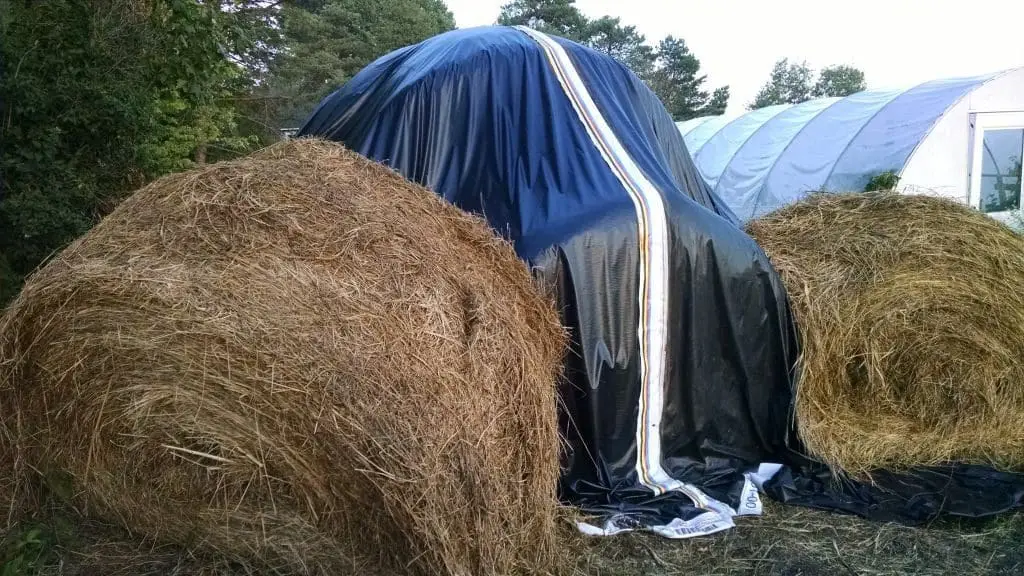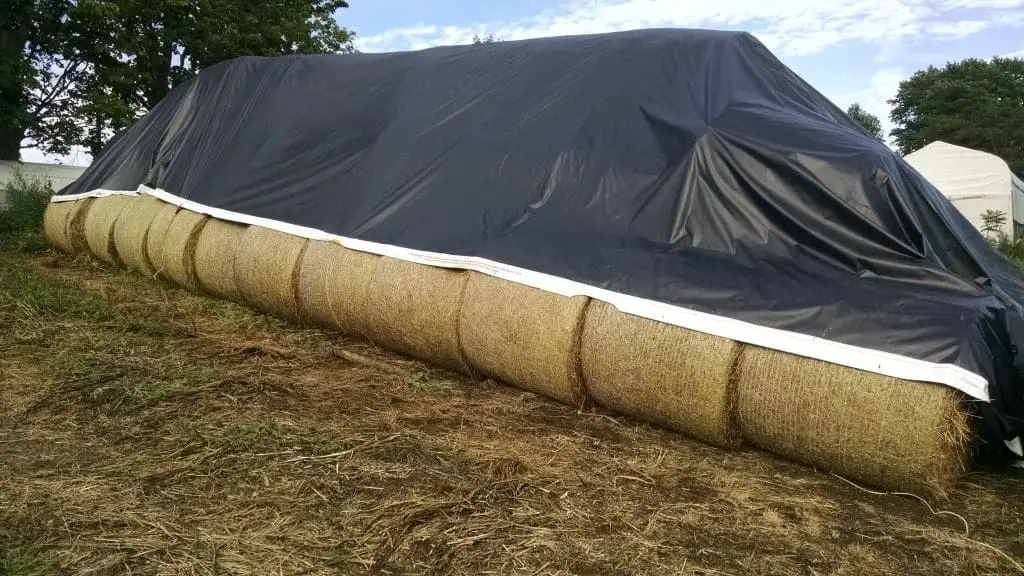This is the first year I’ve had all my hay bales under cover. We were able to cram the sows’ winter hoophouse full of bales. We’ll need to empty that out by Thanksgiving, but it is a pretty convenient place to stash the bales in the meantime.
We’re also trying storing hay under tarps. My friend and farming doppelganger Edmund brought me a stack of used billboard vinyl tarps. I ran ropes and strapping under the bales and then snugged them down using ratchet straps attached to short lengths of scrap pipe in the pipe pockets. I weighed down the wild ends with junk bales.

My stack of 4×4 bales is built in a 3-2-1 configuration. This is covered with a 20×60 tarp, which is is a little too short. My stack of 6×4 bales is in a 2-1 configuration and covered by two standard 11 foot wide tarps glued together with shower liner cement. This one hangs down a little too low to the ground, so in retrospect I should have switched covers. The optimal tarp would completely cover the shoulder of the lowest level of bales while maintaining the airflow at ground level to allow for drying.

Evaluating the economics of covering bales is complicated. The best way to preserve bales would be to build a traditional barn or a hoop building, but that is a big investment. The cheapest and easiest solution is to leave the bales in the field, but that guarantees a ring of spoiled hay at least six inches around the entire bale. Larger bales theoretically enjoy a better core to surface ratio, but I’ve found that the larger twine wrapped bales don’t shed water as well as smaller net wrapped bales. (Some of this is related to the baling machines available to me, perhaps different balers would give different outcomes.) Inline wrapping dry hay is another option. Besides the environmental problem of all the single-use plastic waste generated, the other problem is that these units cost a lot of money for a machine that is used a few days each year. And the cost of the wrapping material isn’t trivial either.
Tarping is low-cost, especially when the tarps are recycled. The trade-off is that it requires more grunt work. I didn’t feel more endangered than I do in other farm projects, but clambering over the highest point of the stack with a heavy, slippery tarp impressed me as a risky activity. I’m also concerned about my ability to manage the tarp in the winter. I’m not sure that I’d be able to fold back the covering with a heavy snow or ice load, so I might be forced to cut the tarp to get at the bales.
The most formidable obstacle I foresee is the wind. I can imagine some tricky scenarios where trying to manage a 1200 square foot tarp during our violent winter windstorms could be downright dangerous. When the cattle need to eat, they need to eat, no matter the conditions. Because of this, I am leaning toward dismantling the bale covers between Thanksgiving and Christmas, when our severe, cold winds start blowing. But that brings me back to the economics questions posed earlier, whether the work of building the stacks and covering them is justified. There might not be a significant value in covering the bales from July though November if I need to leave them exposed from December to March or April.
Just for fun: the inevitability of working in foul, windy weather puts me in mind of the opening lines of Bilgewater by Brown Bird.
It don’t matter if the cold wind blows
I’m gonna wind up working in the thick of it

5 thoughts on “Tarping Round Bales”
Interesting. Last year was our first winter of bale grazing (it was also our first winter of cattle) and, the way the field lies where we were wintering the cattle, I was glad to have them all set out ahead of time, since with the warm winter there was often nasty mud. About half of what we fed last year was baleage which we just unwrapped as we went, so we didn’t have to worry about spoilage for that.
I’ll be on the lookout for some billboard tarps though. I can imagine all sorts of uses for those.
Very true that there are a lot of times during the winter where either snow or mud make tractoring the bales impossible.
If you are still planning on setting them all out and bale grazing, why worry about the ice and snow. Or, if you aren’t planning on doing bale grazing this winter, why not?
I am planning on bale grazing. The advantage of tarping the bales lies in reducing the amount of spoilage. I’m not sure that the effort of tarping outweighs the spoiling, but it might. The hybrid system would involve a “just-in-time” approach to lay out just a few day’s of at most a few week’s worth of bales at a time throughout the winter. This would combine the low-infrastructure advantages of bale grazing with the higher quality of unweathered hay.